Fully Automated QuEChERS Extraction and Cleanup of Organophosphate Pesticides in Orange Juice
A fully automated quick, easy, cheap, effective, rugged, and safe (QuEChERS) extraction and extract clean-up method for gas chromatography–mass spectrometry (GC–MS) and liquid chromatography–mass spectrometry (LC–MS) analysis is presented using an industry standard robotic x,y,z-sampling system. This article analyzes organophosphate pesticides from orange juice. The automated workflow used in the study includes the extraction with acetonitrile and salting out and using a μSPE cartridge for matrix cleanup prior to injection into a gas chromatography–tandem mass spectrometry (GC–MS/MS) system. The method validation techniques, such as pre-spike and post-spike, were fully integrated into the automated workflow. Calibration linearities of the organophosphate pesticides in orange juice matrix range from 1 to 100 ng/mL with a precision achieved better than 0.995 for all compounds. By spiking 10 ng/mL of pesticides into the orange juice samples, recoveries were obtained in the range of 70–115%, while the precision from pre-spike (n = 7) and post-spike (n = 6) under the same concentration was less than 10% RSD. The calculated method detection limits (MDLs) of the monitored pesticides were in the range of 1.8–4.1 ng/mL, which are well below the regulated maximum residue limits (MRLs) of 10 ng/g for these pesticides.
Quick, easy, cheap, efficient, rugged, and safe (QuEChERS) is the well-established pesticide extraction procedure developed by M. Anastassiades and S.J. Lehotay in 2003 (1). Since then, this technique has become a widely used sample preparation approach in pesticide residue analyses. According to the QuEChERS website, approximately 45 min are needed to manually prepare eight samples in the laboratory for subsequent gas chromatography–mass spectrometry (GC–MS) or liquid chromatography–mass spectrometry (LC–MS) analysis (2). In the traditional QuEChERS method, acetonitrile is used as the extraction solvent for an aqueous sample of approximately 10 g, followed by adding buffer salts for phase separation and pH adjustment, and an intense shaking of the mixture. After centrifugation, the cleanup of the raw extracts is manually achieved via dispersive solid-phase extraction (dSPE) using a combination of different sorbent materials. Clean-up sorbents like primary and secondary amine (PSA), which include mainly removing sugars, organic acids, and pigments; graphitized carbon black (GCB), which removes pigments and nonpolar interferences); C18 (removing lipids and other nonpolar interferences) and other specific sorbent materials can remove chlorophyll, and are used in varying ratios to suit different matrix conditions. Anhydrous magnesium sulfate is added for water removal in case of subsequent GC–MS analysis.
The steps for pesticide residue analysis starts with the representative sampling and comminution pre-treatment, which are the necessary manual steps to provide a homogeneous subsample for processing. Solid samples like plant materials, food, or soil require individually optimized homogenization of a representative sample size by cutting, grinding, or milling, including cryomilling for volatile analytes (3,4). This comminution of raw sample materials to achieve a representative aliquot as a test portion for analysis is typically done manually. Vegetable and fruit juices are considered homogenous after thoroughly shaking the commercial packaging, the bottles or carton packages before transferring an aliquot to analysis vials.
This report describes for the first time a fully automated QuEChERS extraction and clean-up workflow for homogeneous matrices like fruit juices—in this case, demonstrated for orange juice—using an industry standard robotic x,y,z-sampling system for online or offline GC–MS and LC–MS pesticide analysis. Only 0.5 mL of homogenized juice are required to transfer the juice into a regular 2 mL autosampler vial for the automated extraction, cleanup, and online analysis. The raw extract clean-up and removal of the high matrix load are achieved by using micro-SPE (μSPE) cartridges. The advantage of using μSPE is that it is a straightforward separation of the pesticide fraction from the matrix by elution of the pesticide fraction through a small sorbent bed, leaving the matrix behind. Extract dilution and solvent evaporation are also avoided, which maintains the initial concentration level of the pesticides and provides high recoveries and short processing times of only a few minutes, being compatible with the chromatographic run times. A prep-ahead mode allows the processing of a next sample during the chromatographic run.
Configuration of the Robotic Sampler
For the described experiments, an industry standard robotic x,y,z-sampling system with automated tool change (x,y,z-Robotic Sampler) was employed. Different syringes sizes for extraction, cleanup, standard addition and GC injection are used in the automated workflow. The system configuration as shown in Figure 1 further comprises a vortex mixer, solvent, and wash modules. The system configuration also incorporates a tray holder with the vial racks for the sample and extract vials, and the micro-SPE clean-up cartridges. A system park station holds the tools with different syringes for use in the programmed workflow.
FIGURE 1: Configuration of the robotic x,y,z-sampler for the automated QuEChERS extraction and cleanup of juice samples. Note the labeled features include: 1) handheld terminal, 2) vortex mixer, 3) solvent module, 4) head of robotic sampler, 5) fast wash module, 6) tray holder for vial racks and μSPE cartridges, and 7) tool park station with three syringes.
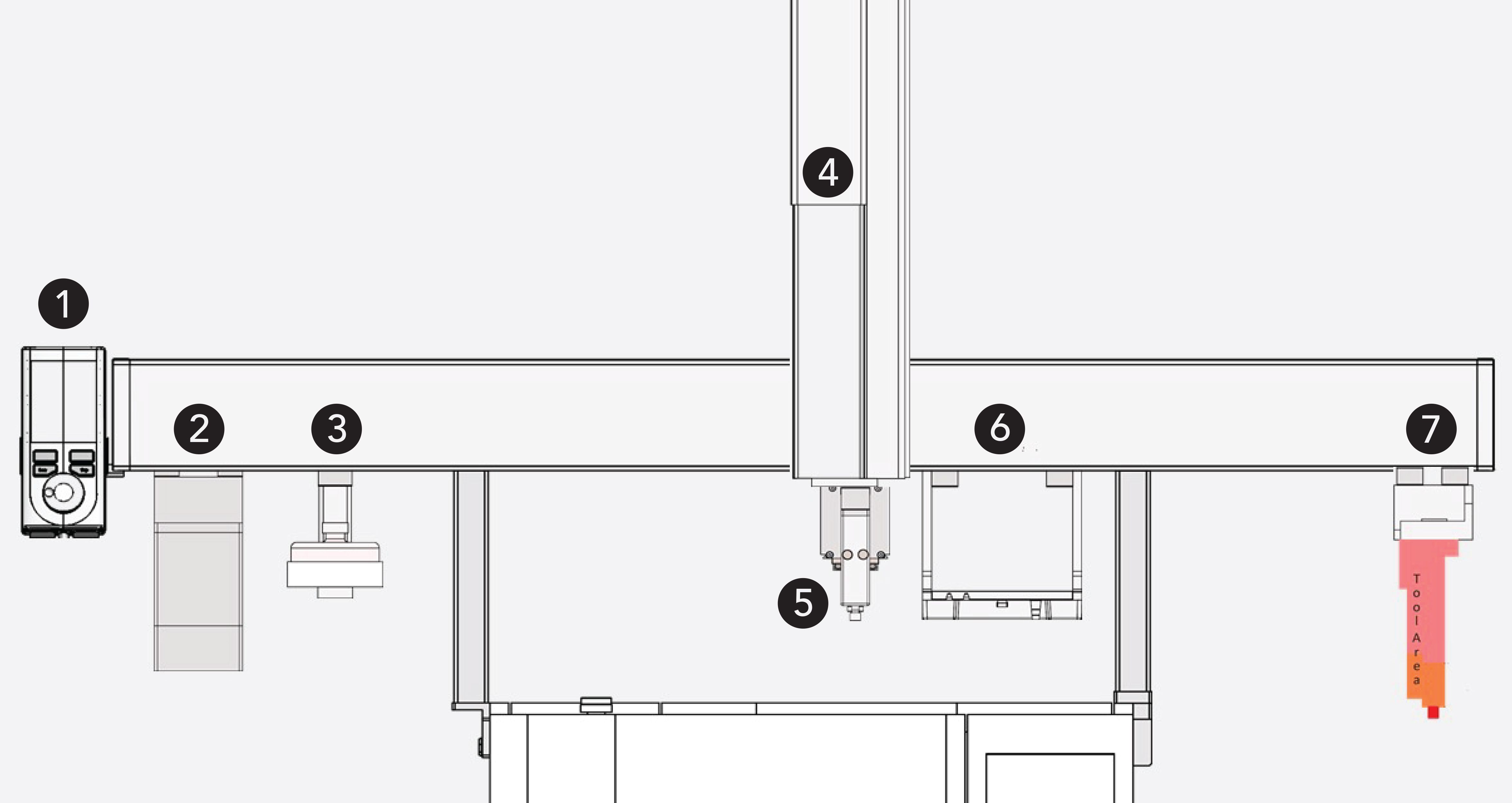
For the automated workflow, a saturated sodium chloride (NaCl) solution is provided in the solvent module. Acetonitrile is used as extraction and syringe cleaning solvent provided with a fast wash module from an external reservoir. The fast wash module includes a pump for solvent delivery, active only when the syringe needle enters the sink-shaped port.
The workflow includes the automated dilution of pesticide standards to build a calibration curve as well. A working stock solution is placed in rack one with a row of empty vials for in-time preparation of the calibration for quantitation, which is shown in Figure 2. The same vial rack carries the sample vials, empty vials to collect the cleaned extract, as well the necessary μSPE cartridges for the cleanup.
FIGURE 2: Tray holder top view showing the rack placement of standards, samples, cleaned extracts, and the μSPE cartridge reservoir.
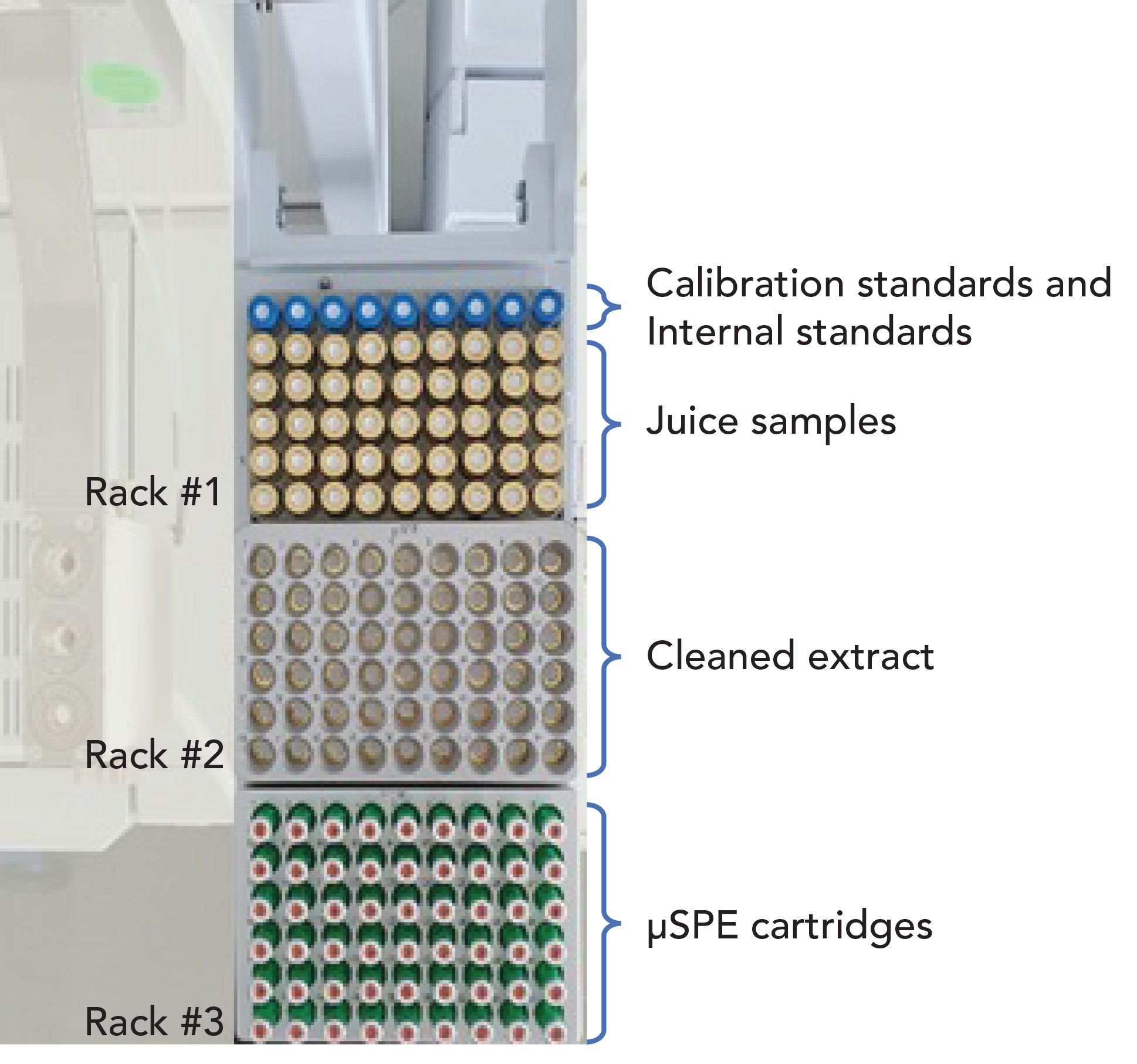
Automated Workflow
The workflow for the automated analysis of pesticides from juices comprises several stages:
- preparation of the calibration standards
- standards addition
- extraction with acetonitrile
- extract cleanup
- GC–MS and LC–MS injections and analyses.
The first part with a fresh preparation of the calibration curve can be used optionally, as well as the addition of internal standards to the sample. Typically, commercial multiresidue pesticide standards are applied for building the quantitative calibration. The dilution of standards can be achieved in routine analysis by entering the required dilution factors. The automated workflow describing the extraction, cleanup, and GC–MS injection steps is illustrated in Figure 3. The QuEChERS extraction step is performed here with the original high NaCl salting-out conditions (1). A pH adjustment following AOAC 2007.01 or EN 15662 methods can be achieved by providing the required buffer salts in accordingly prepared 2 mL vials before adding a juice sample.
FIGURE 3: Automated workflow for juice extraction, extract cleanup, and GC injection. MeCN indicates the use of acetonitrile (methyl cyanide).
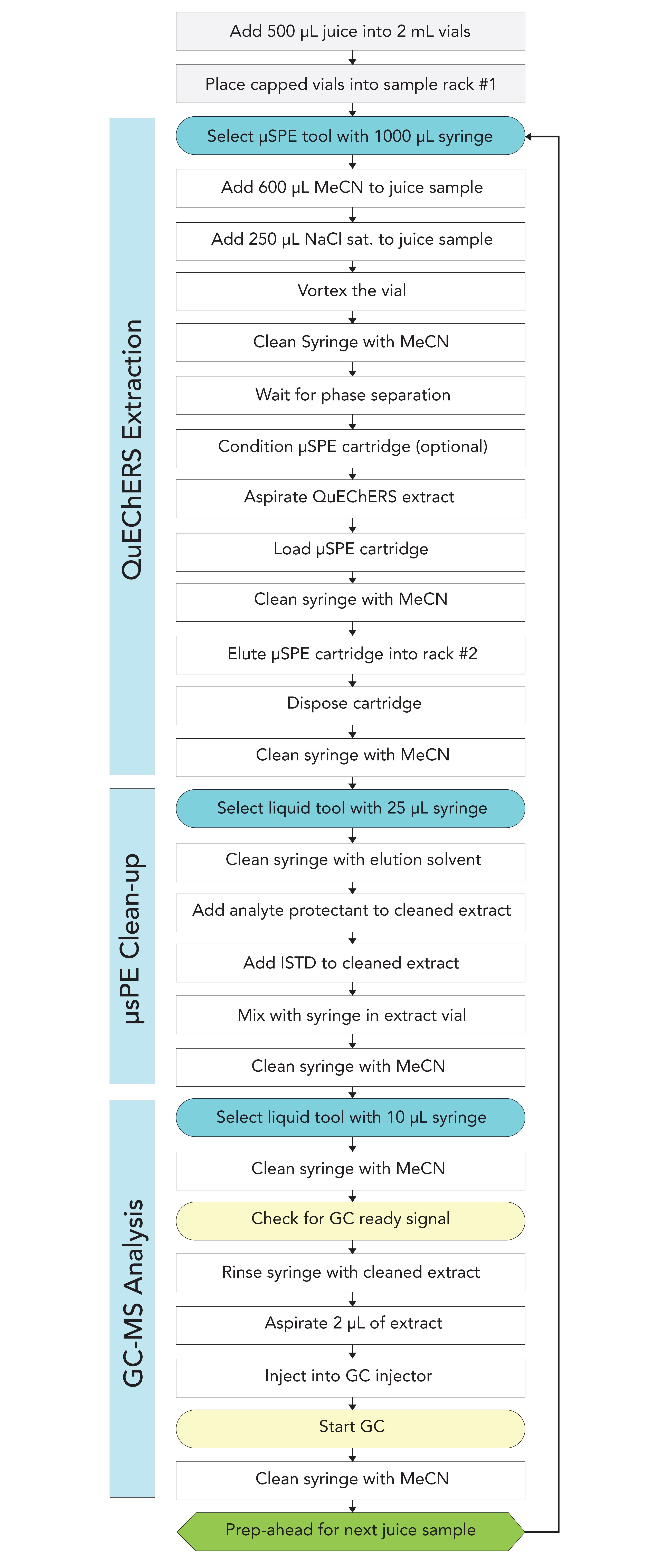
The extract cleanup is achieved by applying the raw extract, after phase separation, to μSPE cartridges. Here the syringe works like an LC pump and pushes the extract in constant slow flow of 2 μL/s through the cartridge. The pesticides fraction is eluted first, leaving the sample matrix behind on the cartridge. The cleaned extract is collected in empty vials on the same tray holder. The sorbent material mix of the clean-up cartridge is optimized for GC–MS and LC–MS analysis (5). Both cartridge types contain C18 and activated carbon material, but only for GC–MS primary and secondary amine (PSA) and anhydrous MgSO4. Silica coated zirconium dioxide (ZrO2) sorbent material is used for LC–MS analysis. A big benefit of the optimized sorbent material mix for laboratory logistics is the wide versatility of the cartridges for any kind of food sample. This also includes samples containing high fat content or spice, making any further modification of the sorbent material mix for different kind of sample matrices unnecessary (6,7).
In the online configuration to GC–MS and LC–MS, every sample is processed on an identical time axis within 5–7 min, depending on the chosen tasks and processed volumes. A “prep-ahead” mode allows the processing of the next sample during analysis of the previous one, as shown in Figure 3. A built-in scheduler of the robotic system starts the processing of a next sample just in time to be ready for injection at the expected ready signal from the mass spectrometer connected. The “prep-ahead” mode increases sample throughput significantly and maximizes the duty cycle of the connected analysis system.
The described workflow integrates into the chromatography data systems of the leading instrument manufacturers for GC–MS and LC–MS. Also, the automated process can be executed off-line, and the cleaned extracts directed to different instruments.
Experimental
The only manual step in the project was transferring orange juice from the well-shaken bottle into sample vials. The subsequent QuEChERS extraction steps, such as adding acetonitrile, adding saturated sodium chloride salt, cleanup, and injection into the GC– MS/MS instrument are all carried out by the x,y,z-robotic sampler with the aid of a method composer software provided by the manufacturer to build the automation workflow. The instruments used were an AOC-6000Plus robot (Shimadzu Corporation), a GC– MS-TQ8040 instrument with GC–MS solutions software (Shimadzu Corporation), and PAL Method Composer software (8) (CTC Analytics). As pesticide standards, the GC multiresidue standards #8 and #9, and as internal standard (ISTD) tris(1,3-dichloroisopropyl) phosphate, were applied (Restek). Solvents and reagents were acetonitrile p.a., as well as sodium chloride reagent grade (Merck KG) and water in HPLC grade (ACRO). The μSPE clean-up cartridge contained a sorbent material mixture containing 45 mg of MgSO4, PSA, C18EC, and CarbonX (CTC Analytics). Orange juice was sourced from a local grocery store.
Results and Discussion
For the automated extraction, the sample size of the homogeneous juice sample is scaled down from the usual sample amount of 10 g to only 400 to 500 μL because less than 10 μL of sample extract is typically injected into the GC–MS instrument to obtain a good signal and recovery.
Figure 4 shows the orange juice sample undergoing QuEChERS sample preparation. The orange juice first is completely miscible with acetonitrile. Only after adding the saturated sodium chloride, two layers of liquid are formed, in which, after being vortexed and followed by sedimentation, the upper layer is the extract of acetonitrile. The bottom layer is the remaining aqueous layer. The colorful extract is typically not suitable to be directly analyzed because of its high matrix co-extracts from the juice sample. An aliquot of this extract is transferred to the μSPE cartridge for cleanup. The clean-up effect can already visually be noticed on colorants removed by the μSPE cartridge after the clean-up procedure.
FIGURE 4: Workflow steps visualized in the 2 mL vials of the automated juice extraction and cleanup. Shown are (a) orange juice from the juice box; (b) orange juice and acetonitrile vortexed; (c) orange juice and acetonitrile, with sodium chloride saturated phase separation; and (d) cleaned extract after the μSPE step, injected.
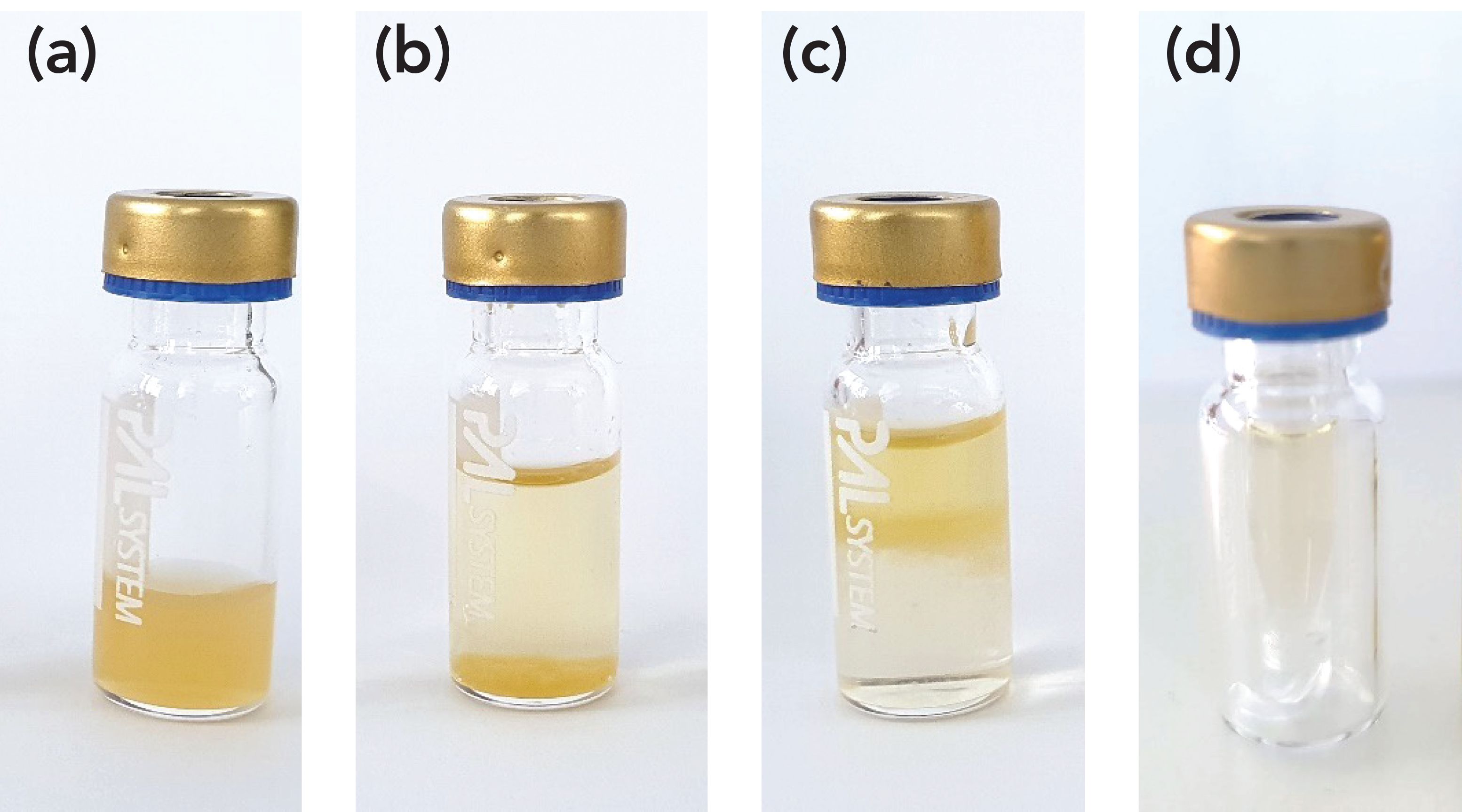
A group of organophosphate pesticides was evaluated based on pre-spike and post-spike of pesticide standards into the juice samples. Using the PAL Method Composer software, the pre-spike and post-spike steps were integrated optionally into the automation workflow. In the pre-spike procedure, the pesticides and internal standards were added into the orange juice sample prior to the extraction with acetonitrile. A post-spike procedure starts with extracting the juice sample followed by μSPE clean-up, then adding the pesticide and internal standards into the cleaned extracts before injecting into the GC–MS/MS instrument.
Chromatograms and Calibration Curves
Figure 5 shows the full chromatograms of the extracted orange juice after undergoing the automated QuEChERS extraction and clean-up using the post-spike of standards with 100 ng/mL of the organophosphate pesticide compounds.
FIGURE 5: Total ion chromatogram of post-spiked orange juice (100 ng/mL) after undergoing the automated QuEChERS extraction and μSPE clean-up. The x-axis is time (min) and the y-axis is signal x 10,000 for all subfigures.
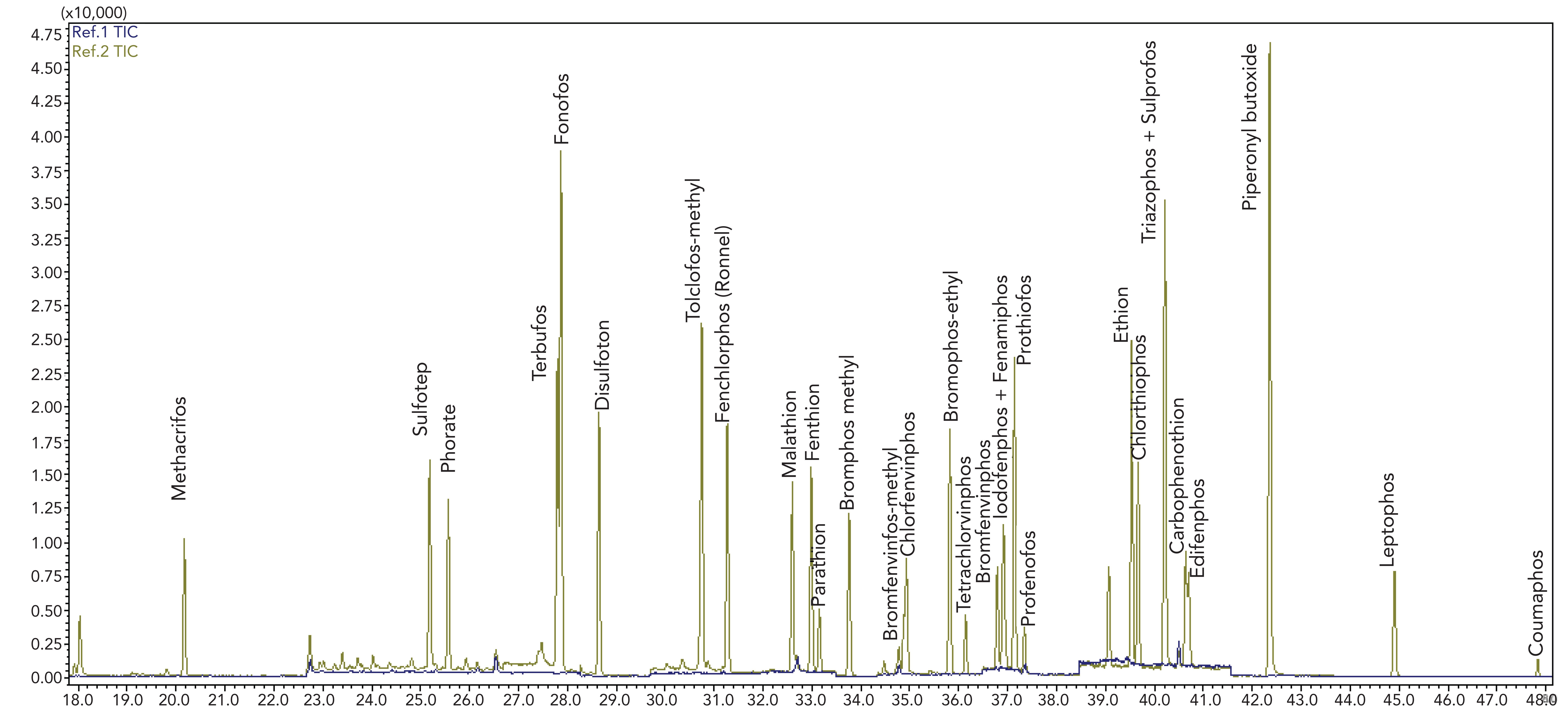
Quantification
The calibration curves were prepared in a concentration range from 1.0 to 100.0 ng/mL with the standards post-spiked into a blank and μSPE-cleaned orange juice extract. A very good linearity with correlation coefficients better than 0.995 for all the investigated organophosphorus pesticides could be achieved. Figure 6 shows the calibration curves of the late eluted compounds piperonyl butoxide, leptophos, and coumaphos, which are representative of the group of compounds.
FIGURE 6: Linear calibration curves post-spiked into μSPE cleaned orange juice extracts of the late eluted compounds piperonyl butoxide, leptophos, and coumaphos. The x-axis is the concentration ratio and the y-axis is the area ratio for all three subfigures.

Pre- and post-spiked data from seven consecutive sample runs were used to calculate the method recovery values and method detection limits (MDL) listed in Table I. The resulting data show a high recovery between 71 and 114% for all pesticides investigated. The MDLs confirm a very good and regulation-compliant sensitivity of the described method. Figure 7 shows selected real-world mass chromatograms of the lower recovery and late eluted compounds at the 10 ng/mL decision level.
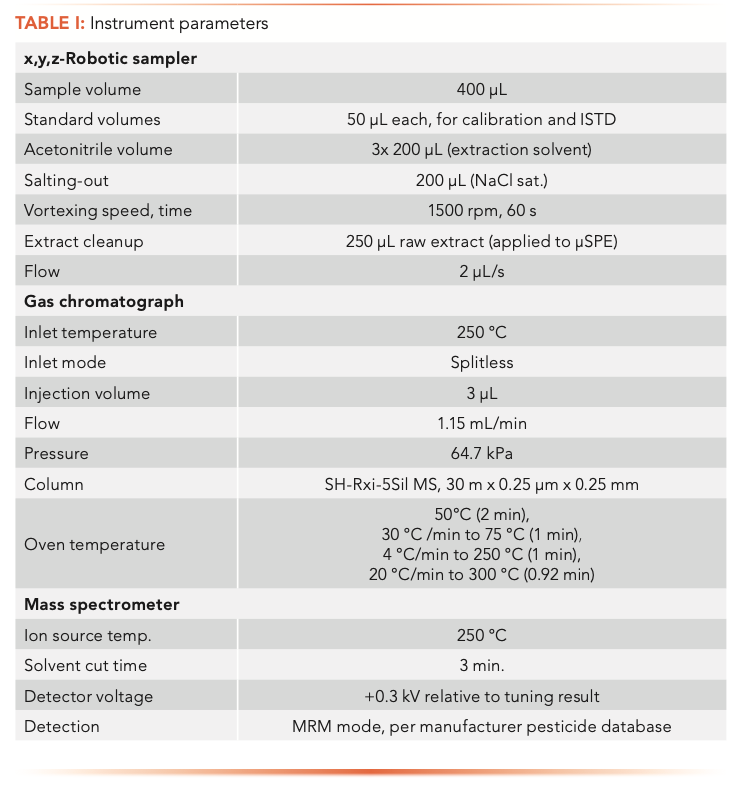
FIGURE 7: Real-world mass chromatograms (3 MRM transitions each) at the 10 ng/mL decision level, showing (a) spike 10 ng/mL, and (b) blank run. The x-axis is time (min) and the y-axis is signal x 100 for all subfigures.
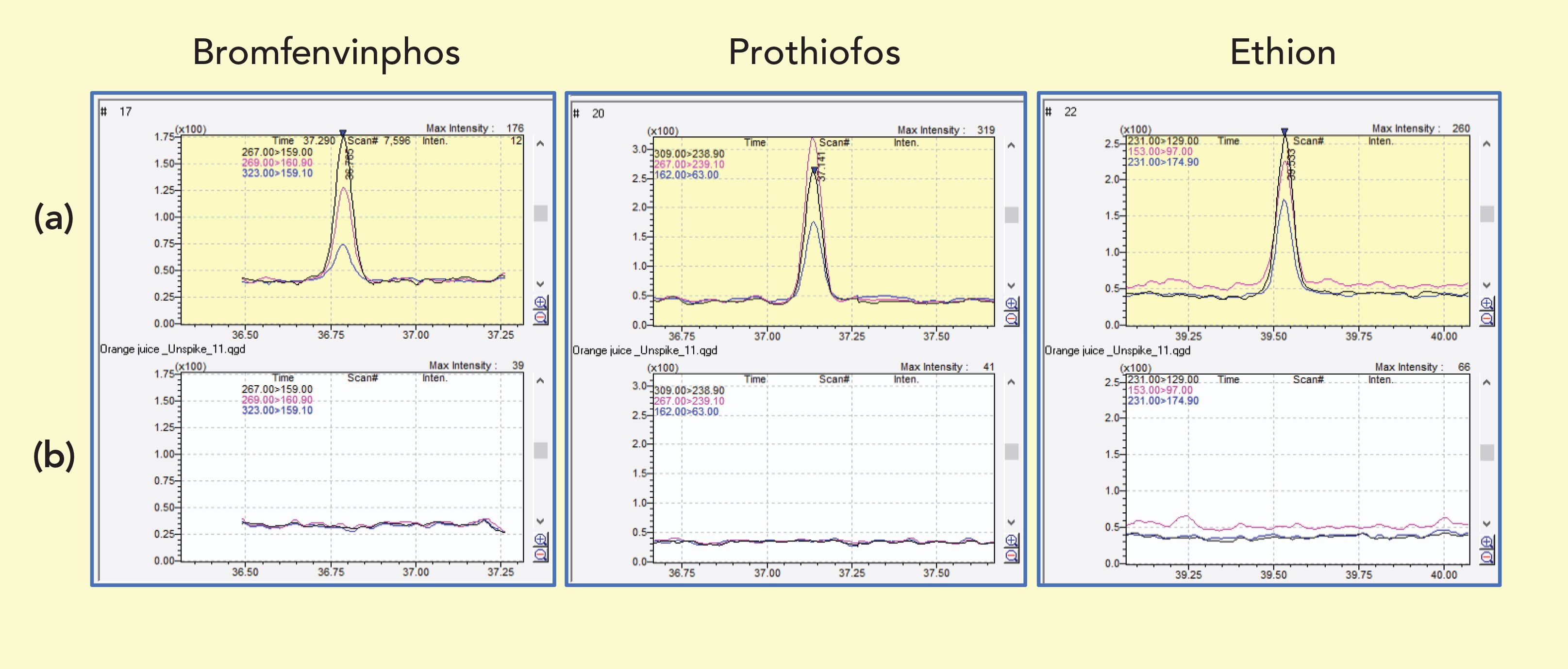
Conclusion
The fully automated QuEChERS extraction and clean-up procedure frees up resources in the routine laboratory. The industry standard x,y,z-robotic sampling system provides a reliable method for pesticide analysis of homogeneous juice samples as shown for organophosphates pesticides analysis from orange juice. The typical high amount of solvents, glassware, and consumables required for pesticide analysis is significantly reduced, providing a green analytical method.
The automated method avoids solvent evaporation steps, uses only one cartridge type for all matrices, and can be executed fast online during a chromatographic run in “prep-ahead” mode optimizing the sample throughput of the MS detection system in use.
The analytical data show excellent sensitivity for the investigated organophosphates pesticides with MDLs in the range of 1–4 ng/mL. The quantitative calibration is linear, in the range of 1–100 ng/L. The method precision at the decision level is excellent, with less than 10% RSD for all compounds, making this automated method a suitable solution for pesticide analysis of homogeneous juice samples. The described automated extraction and clean-up workflow can be applied for unattended online GC– MS and LC–MS analysis.
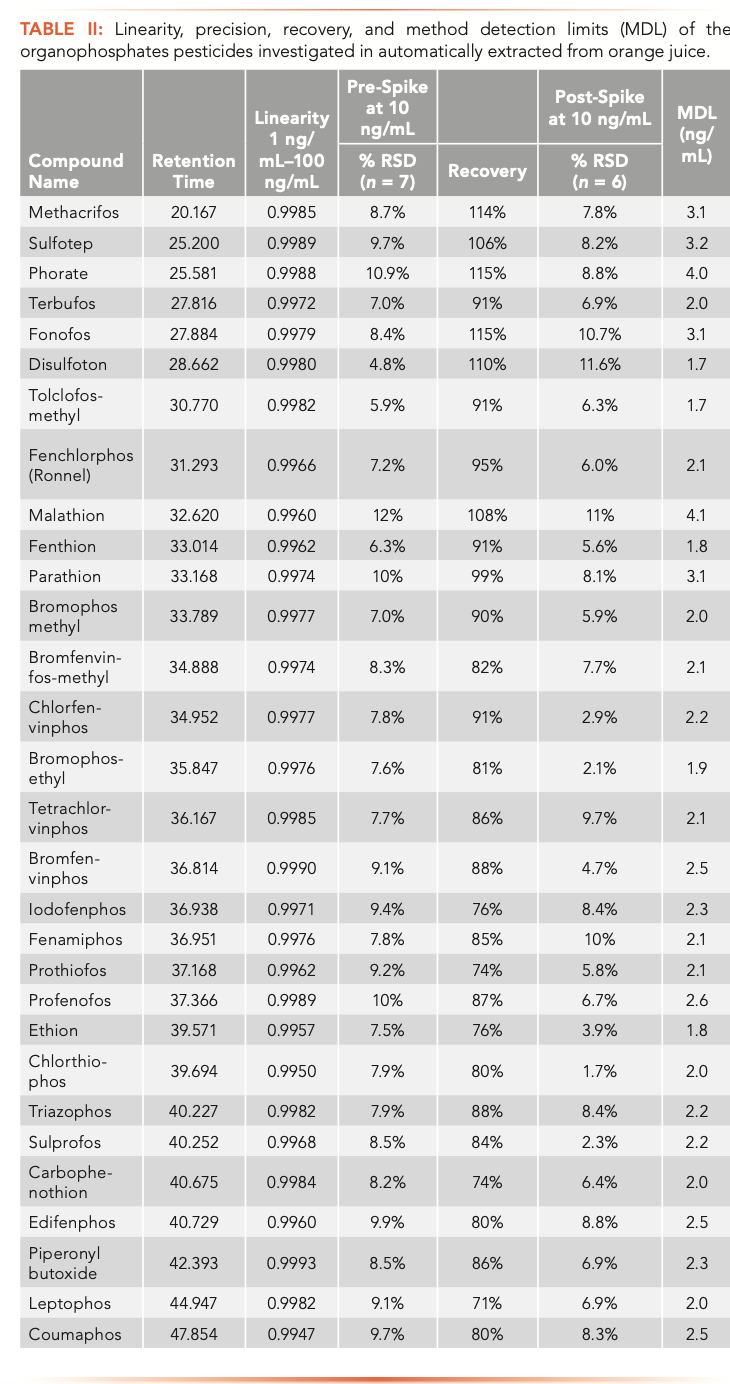
References
(1) M. Anastassiades, S.J. Lehotay, D. Stajnbaher and F.J. Schenck, JAOAC Int 86(2) 412–431 (2003).
(2) QuEChERS, https://www.quechers.com/index.php (as of Jan 11, 2021)
(3) S.J. Lehotay, N. Michlig, and A.R. Lightfield, J. Agric. Food Chem. 68(5), 1468–1479 (2020). doi.org/10.1021/acs.jafc.9b07685.
(4) SANCO, “Guidance Document on Analytical Quality Control and Validation Procedures for Pesticide Residues Analysis in Food and Feed.” European Commission Health & Consumer Protection Directorate General (2011). www.eurl-pesticides.eu/library/docs/allcrl/AqcGuidance_ Sanco_2013_12571.pdf.
(5) B.D. Morris and R.B. Schriner, J. Agric. Food Chem. 63, 5107−5119 (2015).
(6) S.J. Lehotay, L. Han, and Y. Sapozhnikova, Chromatographia 79, 1113–1130 (2016). DOI: 10.1007/s10337-016-3116-y.
(7) A. Goon, R. Shinde, et al, J. AOAC Int. 103(1) 40–45 (2019). DOI: https://doi.org/10.5740/jaoacint.19-0202.
(8) PAL Method Composer User Manual, version 1.3. 2020. CTC Analytics AG, Zwingen, Switzerland. https://www.palsystem.com/index.php?id=850
Chiew Mei Chong and Hans-Joachim Hübschmann are with CTC Analytics Pte. Ltd. in Singapore. Direct correspondence to: hjhuebschmann@ctc.ch
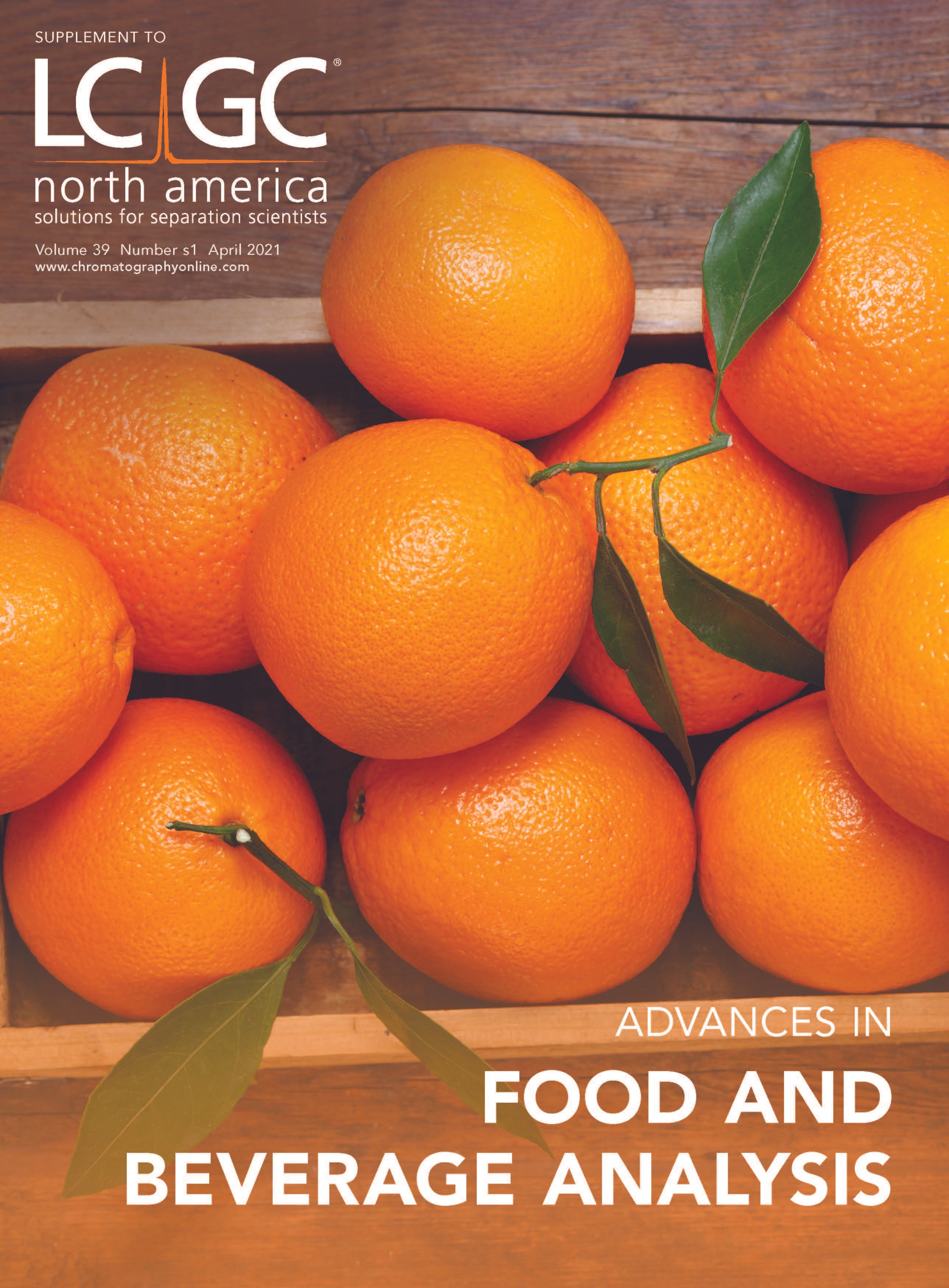
New Study Reviews Chromatography Methods for Flavonoid Analysis
April 21st 2025Flavonoids are widely used metabolites that carry out various functions in different industries, such as food and cosmetics. Detecting, separating, and quantifying them in fruit species can be a complicated process.
Analytical Challenges in Measuring Migration from Food Contact Materials
November 2nd 2015Food contact materials contain low molecular weight additives and processing aids which can migrate into foods leading to trace levels of contamination. Food safety is ensured through regulations, comprising compositional controls and migration limits, which present a significant analytical challenge to the food industry to ensure compliance and demonstrate due diligence. Of the various analytical approaches, LC-MS/MS has proved to be an essential tool in monitoring migration of target compounds into foods, and more sophisticated approaches such as LC-high resolution MS (Orbitrap) are being increasingly used for untargeted analysis to monitor non-intentionally added substances. This podcast will provide an overview to this area, illustrated with various applications showing current approaches being employed.

.png&w=3840&q=75)

.png&w=3840&q=75)



.png&w=3840&q=75)



.png&w=3840&q=75)





